AMD's Radeon HD 6970 & Radeon HD 6950: Paving The Future For AMD
by Ryan Smith on December 15, 2010 12:01 AM ESTPower, Temperature, & Noise
Last but not least as always is our look at the power consumption, temperatures, and acoustics of the Radeon HD 6900 series. This is an area where AMD has traditionally had an advantage, as their small die strategy leads to less power hungry and cooler products compared to their direct NVIDIA counterparts. However NVIDIA has made some real progress lately with the GTX 570, while Cayman is not a small die anymore.
AMD continues to use a single reference voltage for their cards, so the voltages we see here represent what we’ll see for all reference 6900 series cards. In this case voltage also plays a big part, as PowerTune’s TDP profile is calibrated around a specific voltage.
| Radeon HD 6900 Series Load Voltage | ||||
| Ref 6970 | Ref 6950 | 6970 & 6950 Idle | ||
| 1.175v | 1.100v | 0.900v | ||
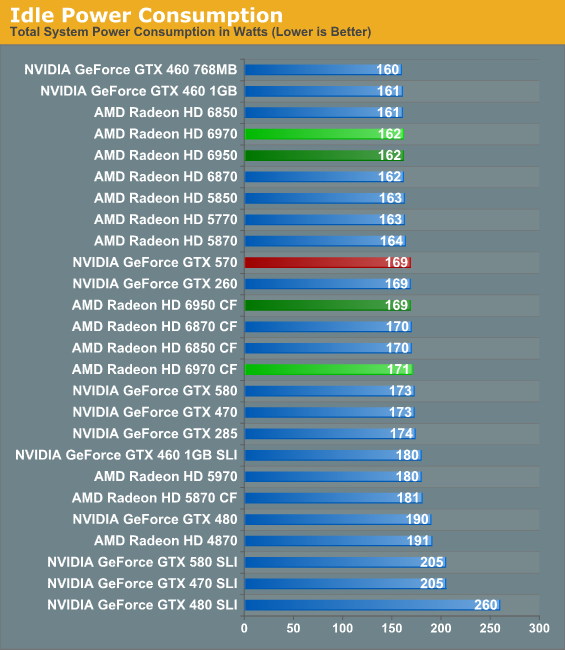
As we discussed at the start of our look at these cards, AMD has been tweaking their designs to take advantage of TSMC’s more mature 40nm process. As a result they’ve been able to bring down idle power usage slightly, even though Cayman is a larger chip than Cypress. For this reason the 6970 and 6950 both can be found at the top of our charts, running into the efficiency limits of our 1200W PSU.
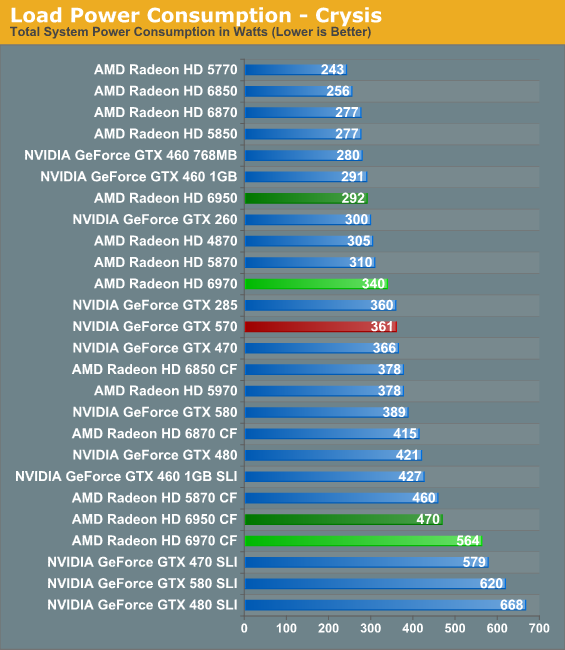
Under Crysis PowerTune is not a significant factor, as Crysis does not generate enough of a load to trigger it. Accordingly our results are rather straightforward, with the larger, more power hungry 6970 drawing around 30W more than the 5870. The 6950 meanwhile is rated 50W lower and draws almost 50W less on the dot. At 292W it’s 15W more than the 5850, or effectively tied with the GTX 460 1GB.
Between Cayman’s larger die and NVIDIA’s own improvements in power consumption, the 6970 doesn’t end up being very impressive here. True, it does draw 20W less, but with the 5000 series AMD’s higher power efficiency was much more pronounced.
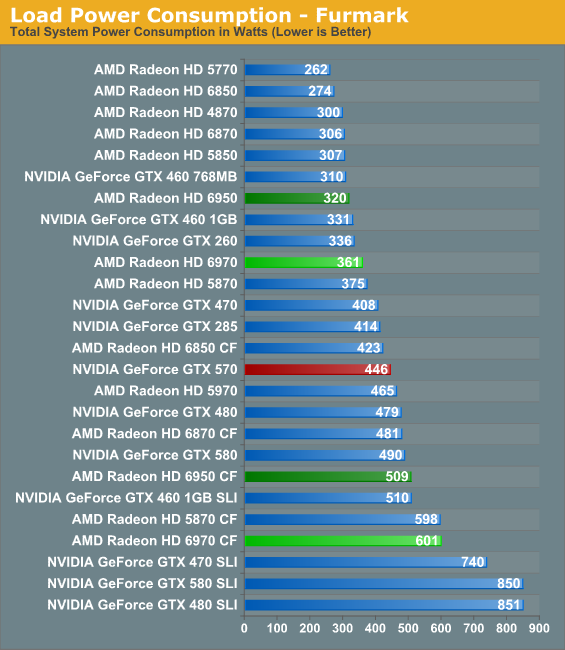
It’s under FurMark that we finally see the complete ramifications of AMD’s PowerTune technology. The 6970, even with a TDP over 60W above the 5870, still ends up drawing less power than the 5870 due to PowerTune throttling. This puts our FurMark results at odds with our Crysis results which showed an increase in power usage, but as we’ve already covered PowerTune tightly clamps power usage to AMD’s TDP, keeping the 6900 series’ worst case scenario for power consumption far below the 5870. While we could increase the TDP to 300W we have no practical reason to, as even with PowerTune FurMark still accurately represents the worst case scenario for a 6900 series GPU.
Meanwhile at 320W the 6950 ends up drawing more power than its counterpart the 5850, but not by much. It’s CrossFire variant meanwhile is drawing 509W,only 19W over a single GTX 580, driving home the point that PowerTune significantly reduces power usage for high load programs such as FurMark.
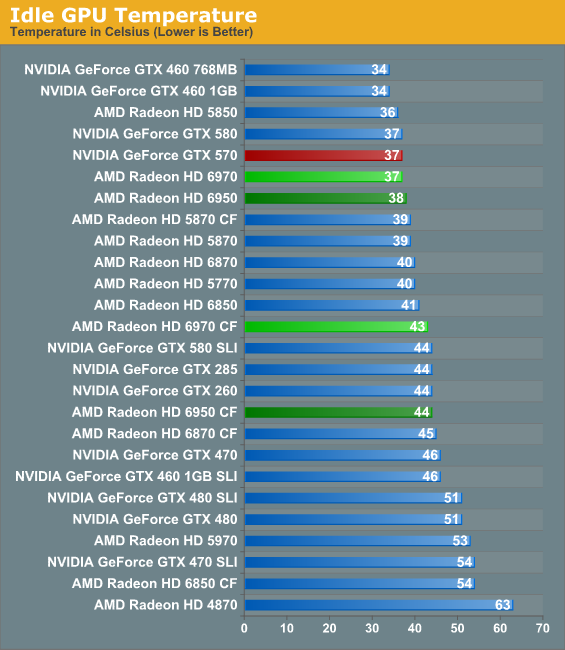
At idle the 6900 series is in good company with a number of other lower power and well-built GPUs. 37-38C is typical for these cards solo, meanwhile our CrossFire numbers conveniently point out the fact that the 6900 series doesn’t do particularly well when its cards are stacked right next to each other.
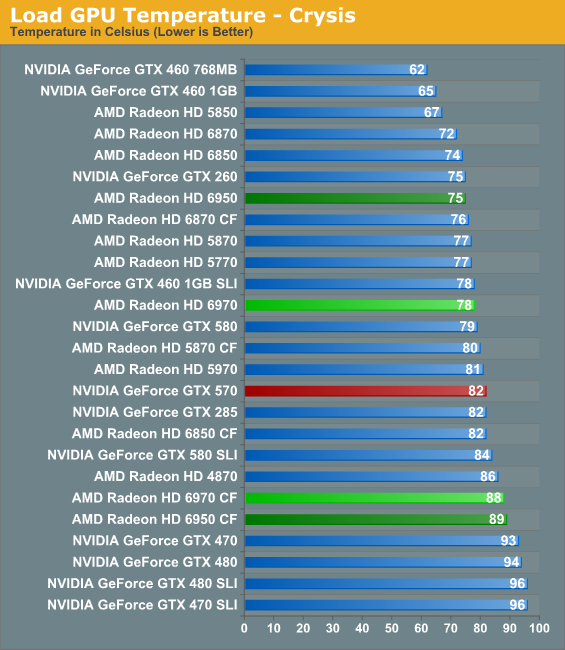
When it comes to Crysis our 6900 series cards end up performing very similarly to our 5800 series cards, a tradeoff between the better vapor chamber cooler and the higher average power consumption when gaming. Ultimately it’s going to be noise that ties all of this together, but there’s certainly nothing objectionable about temperatures in the mid-to-upper 70s. Meanwhile our 6900 series CF cards approach the upper 80s, significantly worse than our 5800 series CF cards.
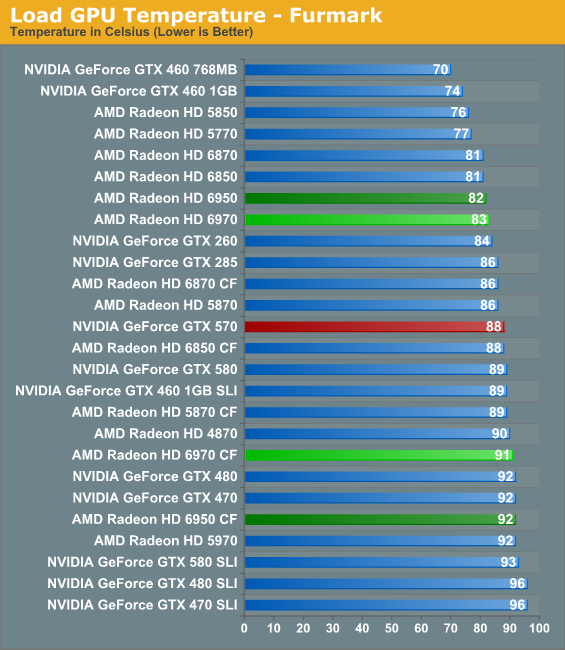
Faced once more with FurMark, we see the ramifications of PowerTune in action. For the 6970 this means a temperature of 83C, a few degrees better than the 5870 and 5C better than the GTX 570. Meanwhile the 6950 is at 82C in spite of the fact that it uses a similar cooler in a lower powered configuration; it’s not as amazing as the 5850, but it’s still quite reasonable.
The CF cards on the other hand are up to 91C and 92C despite the fact that PowerTune is active. This is within the cards’ thermal range, but we’re ready to blame the cards’ boxy design for the poor CF cooling performance. You really, really want to separate these cards if you can.
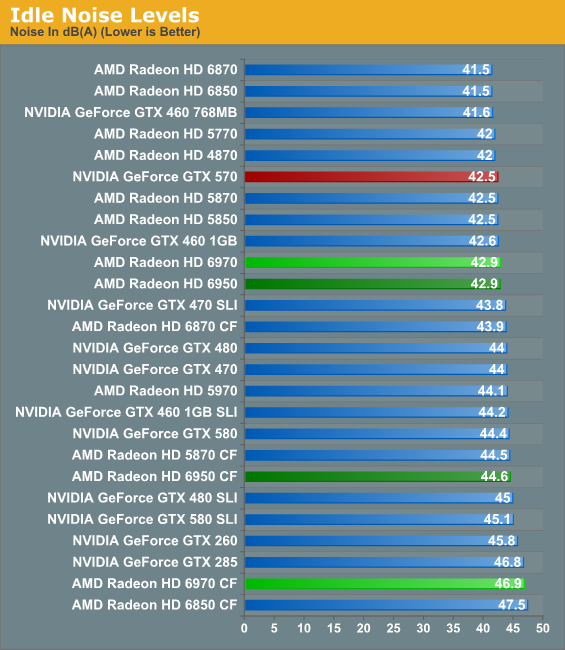
At idle both the 6970 and 6950 are on the verge of running in to our noise floor. With today’s idle power techniques there’s no reason a card needs to have high idle power usage, or the louder fan that often leads to.

Last but not least we have our look at load noise. Both cards end up doing quite well here, once more thanks to PowerTune. As is the case with power consumption, we’re looking at a true worst case scenario for noise, and both cards do very well. At 50.5db and 54.6db neither card is whisper quiet, but for the gaming performance they provide it’s a very good tradeoff and quieter than a number of slower cards. As for our CrossFire cards, the poor ventilation pours over in to our noise tests. Once more, if you can separate your cards you should do so for greatly improved temperature and noise performance.










168 Comments
View All Comments
AnnihilatorX - Thursday, December 16, 2010 - link
I disagree with you rarsonThis is what sets Anandtech apart, it has quality over quantity.
Anandtech is the ONLY review site which offers me comprehensive information on the architecture, with helpful notes on the expected future gaming performance. It mention AMD intended the 69xx to run on 35nm, and made sacrifices. If you go to Guru3D''s review, the editor in the conclusion stated that he doesn't know why the performance lacks the wow factor. Anandtech answered that question with the process node.
If you want to read reviews only, go onto google and search for 6850 review, or go to DailyTech's daily recent hardware review post, you can find over 15 plain reviews. Even easier, just use the Quick Navigation menu or the Table of Content in the freaking first page of article. This laziness does not entrice sypathy.
Quidam67 - Thursday, December 16, 2010 - link
Rarson's comments may have been a little condescending in their tone, but I think the critism was actually constructive in nature.You can argue the toss about whether the architecture should be in a separate article or not, but personally speaking, I actually would prefer it was broken out. I mean, for those who are interested, simply provide a hyper-link, that way everyone gets what they want.
In my view, a review is a review and an analysis on architecture can compliment that review but should not actually a part of the review itself. A number of other sites follow this formula, and provide both, but don't merge them together as one super-article, and there are other benefits to this if you read on.
The issue of spelling anf grammer is trivial, but in fact could be symptomatic of a more serious problem, such as the sheer volume of work Ryan has to perform in the time-frame provided, and the level of QA being squeesed in with it. Given the nature of NDA's, perhaps it might take the pressure off if the review did come first, and the architecture second, so the time-pressures weren't quite so restrictive.
Lastly, employing a professional proof-reader is hardly an insult to the original author. It's no different than being a software engineer (which I am) and being backed up by a team of quality test analysts. It certainly makes you sleep better when stuff goes into production. Why should Ryan shoulder all the responsibility?
silverblue - Thursday, December 16, 2010 - link
I do hope you're joking. :) (can't tell at this early time)Arnulf - Thursday, December 16, 2010 - link
"... unlike Turbo which is a positive feedback mechanism."Turbo is a negative feedback mechanism. If it was a positive feedback mechanism (= a consequence of an action resulting in further action in same direction) the CPU would probably burn up almost instantly after Turbo triggered as its clock would increase indefinitely, ever more following each increase, the higher the temperature, the higher the frequency. This is not how Turbo works.
Negative feedback mechanism is a result of an action resulting in reaction (= action in the opposite direction). In the case of CPUs and Turbo it's this to temperature reaction that keeps CPU frequency under control. The higher the temperature, the lower the frequency. This is how Turbo and PowerTune work.
The fact that Turbo starts at lower frequency and ramps it up and that PowerTune starts at higher frequency and brings it down has no bearing on whether the mechanism of control is called "positive" or "negative" feedback.
Considering your fondness for Wikipedia (as displayed by the reference in the article) you might want to check out these:
http://en.wikipedia.org/wiki/Negative_feedback
http://en.wikipedia.org/wiki/Positive_feedback
and more specifically:
http://en.wikipedia.org/wiki/Negative_feedback#Con...
Ryan Smith - Thursday, December 16, 2010 - link
Hi Arnulf;Fundamentally you're right, so I won't knock you. I guess you could say I'm going for a very loose interpretation there. The point I'm trying to get across is that Turbo provides a performance floor, while PowerTune is a performance ceiling. People like getting extra performance for "free" more than they like "losing" performance. Hence one experience is positive and one is negative.
I think in retrospect I should have used positive/negative reinforcement instead of feedback.
Soda - Thursday, December 16, 2010 - link
Anyone noticed that the edge missing og the boards 8-pin power connector ?Apparently the AMD made a mistake in the reference design of the board and didn't calculating the space needed by the cooler.
If you look closely on the power connector in http://images.anandtech.com/doci/4061/6970Open.jpg you'll notice the missing edge.
For a full story on the matter you can go to http://www.hardwareonline.dk/nyheder.aspx?nid=1060...
For the english speaking people I suggest the googlish version here http://translate.google.com/translate?hl=da&sl...
There are some pictures to backup the claim the mistake made AMD here.
Though it haven't been confirmed by AMD if this is only a mistake on the review boards or all cards of the 69xx series.
versesuvius - Thursday, December 16, 2010 - link
I have a 3870, on a 17 inch monitor, and everything is fine as long as games go. The hard disk gets in the way sometimes, but that is just about it. All the games run fine. No problem at all. Oh, there's more: They run better on the lousy XBOX. Why the new GPU then? Giant monitors? Three of them? Six of them? (The most fun I had on Anandtech was looking at pictures of AT people trying to stabilize them on a wall). Oh, the "Compute GPU"? Wouldn't that fit on a small PCI card, and act like the old 486 coprecessor, for those who have some use for it? Or is it just a silly excuse for not doing much at all, or rather not giving much to the customers, and still charge the same? The "High End"! In an ideal world the prices of things go down, and more and more people can afford them. That lovely capitalist idea was turned on its head, sometime in the eighties of the last century, and instead the notion of value was reinvented. You get more value, for the same price. You still have to pay $400 for your graphic card, even though you do not need the "Compute GPU", and you do not need the aliased superduper antialiasing that nobody yet knows how to achieve in software. Can we have a cheap 4870? No that is discontinued. The 58 series? Discontinued. There are hundreds of thousands or to be sure, millions of people who will pay 50 dollars for one. All ATI or Nvidia need to do is to fine tune the drivers and reduce power consumption. Then again, that must be another "High End" story. In fact the only tale that is being told and retold is "High End"s and "Fool"s, (i.e. "We can do whatever we want with the money that you don't have".) Until better, saner times. For now, long live the console. I am going to buy one, instead of this stupid monstrosity and its equally stupid competitive monstrosity. Cheaper, and gets the job done in more than one way.End of Rant.
God Bless.
Necc - Thursday, December 16, 2010 - link
So True.Ananke - Thursday, December 16, 2010 - link
Agree. I have 5850 and it does work fine, and I got it on day one at huge discount, but still - it is kind of worthless. Our entertainment comes more exclusively from consoles, and I discrete high end card that commands above $100 price tag is worthless. It is nice touch, but I have no application for it in everyday life, and several months later is already outdated or discontinued.My guess, integrated in the CPU graphics will take over, and the mass market discrete cards will have the fate of the dinosaurs very soon.
Quidam67 - Thursday, December 16, 2010 - link
Wonderfully subversive commentary. Loved it.Still, the thing I like about the High end (I'll never buy it until my Mortgage is done with) is that it filters down to the middle/low end.
Yes, lots of discontinued product lines but for example, I thought the HD5770 was a fantastic product. Gave ample performance for maintstream gamers in a small form-factor (you can even get it in single slot) with low heat and power requirements meaning it was a true drop-in upgrade to your existing rig, with a practical upgrade path to Crossfire X.
As for the xbox, that hardware is so outdated now that even the magic of software optimisation (a seemingly lost art in the world of PC's) cannot disguise the fact that new games are not going to look any better, or run any faster, than those that came out at launch. Was watching GT5 in demo the other day and with all the hype about how realistic it looks (and plays) I really couldn't get past the massive amount of Jaggies on screen. Also, very limited damage modelling, and in my view that's a nod towards hardware limitations rather than a game-design consideration.